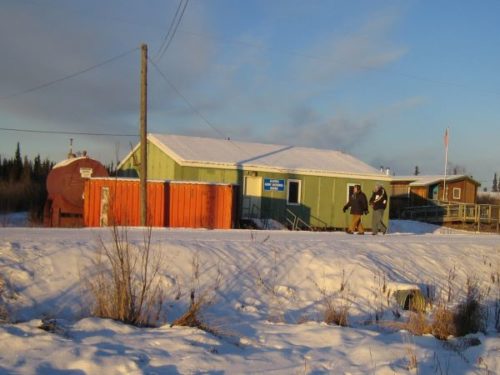Divestiture program continues to benefit communities across rural Alaska

JOINT BASE ELMENDORF-RICHARDSON, Alaska — The Alaska Army National Guard Divestiture Program handed over its 37th site, a Federal Scout Readiness Center built during the Cold War, to Gambell’s Sivuqaq Incorporated in May.
The St. Lawrence Island community will continue to use the building as the Native Village of Gambell Office and headquarters for their search and rescue operations, but now the building belongs to them.
“The building is older than me,” said Kristi Apangalook, tribal coordinator for the Native Village of Gambell, who mentioned the possibilities of now being able to paint and spruce up the building.
“It’s hard to get office space in rural Alaska,” said Apangalook, who explained that the building is a place where community members can get things like information on summer community events. “Several programs are run in the armory, we hold our tribal council meetings and other gatherings here.”
The divestiture of armories began in 2011 due to federal regulation dictating disposal of government property when it is in excess of government needs.
Rural communities who have received divested armories have turned the buildings into public infrastructure for safety and emergency operations, community centers, classrooms and other utilization options that benefit local Alaskans.
“Over the years, and prior to divestiture, many of these sites were and continue to be U.S. Post Offices, health clinics, Boys and Girls Clubs, and most recently, isolation and care facilities for COVID 19,” said Kevin Vakalis, a realty officer with the Department of Military and Veterans Affairs Facility Maintenance Office who has been working with the divestiture program since 2018.
According to Vakalis, the present-day sites are functioning far differently from their original purpose of providing early warning measures and strategic defense during World War II and the Cold War in Alaska.
During World War II, thousands of Alaska Natives, known as Eskimo Scouts, volunteered to serve as sentries – conducting patrols and constantly observing the Bering Sea coastline to provide early warning in case of Japanese invasion – in the Alaska Territorial Guard. The one of a kind, highly specialized, small-unit organization was a U.S. Army reserve force that was formed in 1942 and operated for five years.
[content id=”79272″]
After the ATG disbanded, many of its former members continued to serve in the Alaska Army National Guard’s Scout Battalions of the 297th Infantry (Alaska Scouts) providing vital strategic purpose defending the western coast throughout the Cold War.
“The Scouts were men and women who used centuries-old Arctic skills to spot probing Soviets,” explained Tom Wolforth, a cultural resources manager for the DMVA. “Their place in the U.S. military was so valuable and respected that they sometimes trained the Army’s elite special operations forces sent up from the Lower 48.”
Continued growth of the Scouts prompted construction for Federal Scout Readiness Centers. These 20-by-60-foot modest metal buildings were built between 1950 and 1961 and similar 30-by-40-foot buildings were constructed in the early 1970s to handle the expanding Guard presence in many villages.
“There were Federal Scout Readiness Centers scattered across Alaska serving as the “Ice Curtain” to combat the “Iron Curtain,” said Vakalis citing a Cold War term describing the political boundary that isolated the then-Soviet Union from the West. “The Scout Battalions were one of the United States’ first line of defense against Soviet aggression, and the armories were used as mobilization centers for state and federal activation of troops.”
Half a century later, many of the FSRCs were in preservation-maintenance status – not staffed, and kept with minimum sustainment necessary to preclude safety hazards. With improved technologies, new weapons systems replacing obsolete systems, cost reduction goals and changes in Alaska National Guard strategy, these historic buildings were left without state or federal military missions.
“These remote locations became phased out due to their cost versus force structure gains,” explained Vakalis. “This, along with stationing reassignments to strengthen the force while promoting strategic efficiencies, was the catalyst to the disposal program’s initiation.”
“While the divestitures save the Department of Military and Veterans Affairs funding, the main interest of the program is to get these facilities into the hands of communities who can use them as quickly as possible,” said Maj. Gen. Torrence Saxe, the AKNG’s Adjutant General and DMVA commissioner. “Leaders within the communities are most familiar with the needs of the community and how best the facilities may be used now and in the future.”
Saxe said that while a National Guard presence in rural Alaska areas has decreased over the last few decades, the organization has a renewed focus on rural operations and expanding its presence in strategic locations across Alaska.
[content id=”79272″]
“We want to continue our rich history of rural Alaska membership within our ranks,” explained Saxe. “Guardsmen from throughout Alaska are a crucial part of who we are as a team, allowing our Hometown Army and Air Force servicemembers to return home and serve locally after they complete military training.”
To meet current mission needs, facilities and properties in 18 locations will remain operational, including: Anchorage, Bethel, Fairbanks, Hooper Bay, Juneau, Kenai, Ketchikan, Kipnuk, Klawock, Kodiak, Kotzebue, Kwethluk, Nome, Quihagak, Sitka, Utqiagvik, Valdez, and Wasilla.
Vakalis said that 39 out of 79 sites remain to be divested, and are in various stages of the federal disposal process.
“This process can take from one to many years depending on land title and contamination cleanup issues. Each site is unique and individualized,” explained Vakalis. “The DMVA, along with the U.S. Army
Corps of Engineers, U.S. Fish and Wildlife Services, Bureau of Land Management, and General Services
Administration continue to move the process along to ensure the ultimate goal of continued use to benefit the local communities.”
While these once bustling armories are being divested, Wolforth pointed out the importance of the historic preservation that is taking place as part of the divestiture program.
“We are creating a historic context book and recently finished an interpretive poster illustrating the history of the Alaska Army National Guard in rural Alaska communities focusing on the role of the Guard and armories in village life,” explained Wolforth. “These publications will help share the unique and substantial history that took place in these buildings residing in the heart of many villages.”
Wolforth is hopeful that the poster and context book will help share the buildings’ stories with a larger audience, as the majority of the structures are off the road system in inaccessible, remote and isolated locations.
“There are numerous people that have been involved in this program from its inception and it has been the culmination of the hard work from all that has led to the program’s success,” said Vakalis.
###[content id=”79272″]








